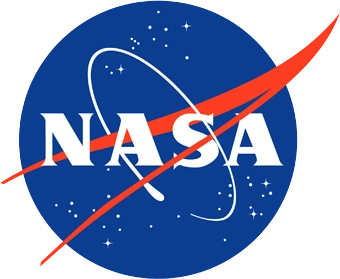JWST Solar System Science
JWST – Solar System Science
The James Webb Space Telescope (JWST) Solar System Science Group serves both the Guaranteed Time Observing (GTO) program team of Dr. Heidi Hammel (AURA) as well as General Observing (GO) investigators with Solar System time and some aspects of the Jupiter ERS Program led by Imke de Pater and Thierry Fouchet. The group consists of members from many institutions across the world, all with the common goal of utilizing the power of JWST for the exploration of our own solar system.
One of JWST’s four main science themes is Planetary Systems and the Origins of Life, and a fundamental aspect of this theme is using JWST to study objects in our own Solar System. JWST was built with the fast-moving and relatively bright objects of our solar system in mind. The observatory is capable of observing everything from Mars outward, from the bright atmosphere of Mars to the faint Kuiper Belt Objects (KBO) that exist in the cold expanses beyond Neptune. JWST has the sensitivity to obtain near-infrared spectra and mid-infrared photometry (albedos) of any KBO known today, and has the capability of monitoring planetary (and satellite) weather for the duration of the mission (potentially up to 20 years) in two intervals of about three months each year.
JWST’s capabilities are highly complementary to current Solar System missions and will also provide foundations for planning future missions. JWST offers high sensitivity and angular resolution at near-infrared and mid-infrared wavelengths. This includes imaging and spectroscopic coverage from 0.6 to 28.5 microns with low to moderate spectral resolving power (~100 to a few thousand). Many important molecules (e.g. H2O, HDO, CO, CO2, S2, CH2), ices, and minerals have strong features in the JWST wavelength range.
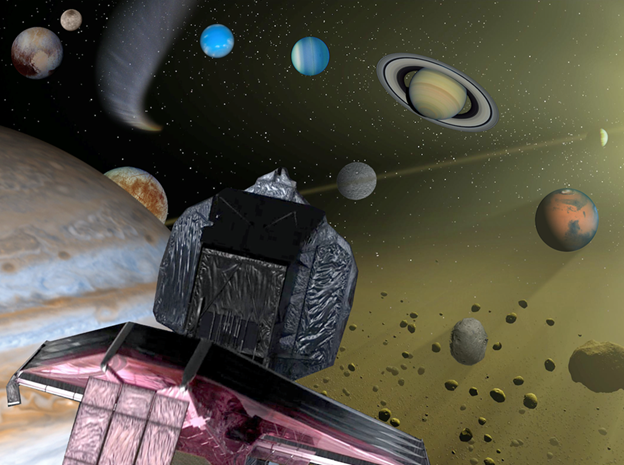
Image credit: NASA/GSFC
The approved JWST Cycle 1 programs for Solar System science span a multitude of science topics:
- Mars
- Jupiter's Great Red Spot
- Saturn
- Uranus
- Neptune
- Kuiper Belt Science
- Trans-Neptunian Objects (TNOS) I and TNOS II
- Large Asteroids and Trojan Asteroids
- Near-Earth Objects (NEOS)
- The Sub-Surface Oceans of Europa and Enceladus
- Titan Climate, Composition, and Clouds
- Titan Climate, Composition, and Clouds
- Comets I and Comets II
- Interstellar Objects
Capabilities of JWST
JWST’s design restricts what can be observed in the inner Solar System. Objects must be more than 85 degrees from the Sun as viewed from L2, which excludes Mercury, Venus, Earth, the Moon, and objects interior to Earth’s orbit, but nearly everything else is fair game. JWST also can’t look farther from the Sun than 135 degrees (i.e., within 45 degrees of the anti-Sun position) but outer solar system objects will all be observable some of the time. These “field of regard” (FOR) limitations are a fundamental consequence of the observatory thermal design and the sunshield design that keeps the telescope and instruments cold.
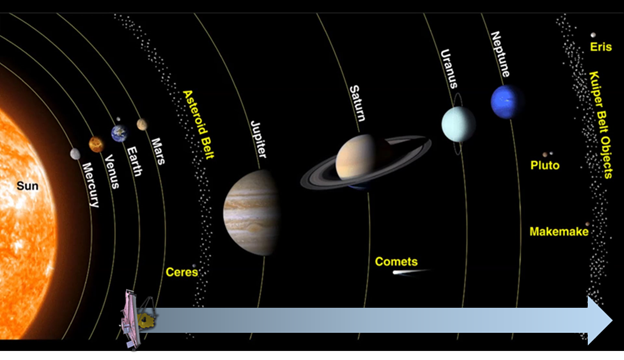
Currently, JWST offers tracking rates for moving targets up to 75 mas/s. This rate was increased from 30 mas/s (Mars at its fastest rate of motion) after the moving target commissioning experiments verified the integrity of observations at these rates (ref: Rigby et al 2022). 75 mas/s enables the tracking of a lot of objects at their optimal observation windows (e.g. Near-Earth Objects, comets approaching perihelion, interstellar objects). Even faster tracking rates were confirmed to work while supporting the DART program in October 2022, but they are highly inefficient; science with such rates would be exceedingly rare and would need an unusually strong justification.
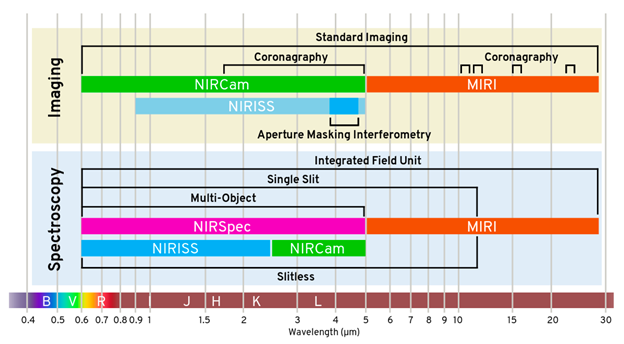
JWST has Four Instruments:
- Near InfraRed Spectrograph (NIRSpec) will do spectroscopy between 0.6 and 5 microns
- Mid-Infrared Instrument (MIRI) has both a camera and a spectrograph that covers the wavelength range of 5 and 28 microns
- Near Infrared Camera (NIRCam) is the JWST’s primary imager and operates over a wavelength range of 0.6 to 5 microns
- Fine Guidance Sensor/Near Infrared Imager and Slitless Spectrograph (FGS/NIRISS) is the combination of a “guider” that allows the JWST to point precisely and a specialized instrument that has a wavelength range of 0.8 to 5 microns.
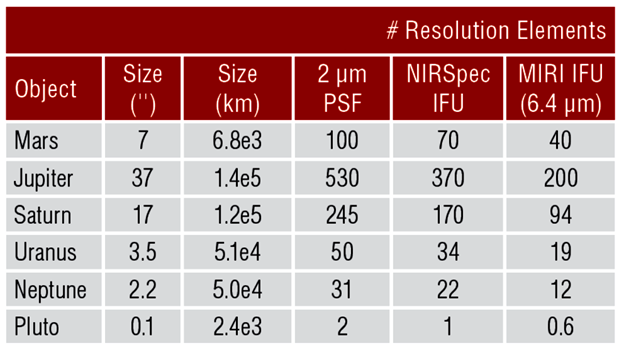
Guaranteed Time Observation Programs for Solar System Science
Guaranteed Time Observation (GTO) programs are awarded to the science teams that contributed significantly to the design and management of key hardware and software components of JWST and/or helped plan the observatory’s scientific mission. Across the first 3 cycles of telescope operation (2022-2025), roughly 16% of available observing time has been dedicated to GTO programs, spanning the full range of JWST science. These programs are designed to be benchmark observations for the JWST mission, and most have no proprietary period, ensuring that the data will be made available to the wider astronomical community immediately.
The full list of approved Cycle 1 GTO programs can be found here: https://www.stsci.edu/jwst/science-execution/approved-programs/cycle-1-gto
Early Release Science Programs for Solar System Science
Early Release Science (ERS) programs were developed by STScI and the JWST Advisory Committee to showcase the capabilities of JWST and help familiarize the broader scientific community with the functionality and data products of the spacecraft’s instrument suite. These observations are scheduled to take place during the first five months of JWST science operations. The ERS programs have no proprietary period, ensuring timely dissemination and analysis of results.
ERS Program 1373, led by Prof. Imke de Pater and Dr. Thierry Fouchet, will carry out detailed observations of the Jovian system using all four of JWST’s science instruments: https://www.stsci.edu/jwst/science-execution/approved-programs/dd-ers/program-1373
General Observer Programs for Solar System Science
The General Observer (GO) program provides the worldwide astronomical community with the opportunity to utilize the state-of-the-art capabilities of JWST to pursue cutting-edge scientific investigations through a competitive proposal process. During Cycle 1, approximately 6000 hours were awarded to GO programs, of which approximately 400 hours are devoted to Solar System science. These programs will observe a wide range of targets, from Near-Earth Objects and comets to the Giant Planets.
The full list of approved Cycle 1 GO programs can be found here: https://www.stsci.edu/jwst/science-execution/approved-programs/cycle-1-go
